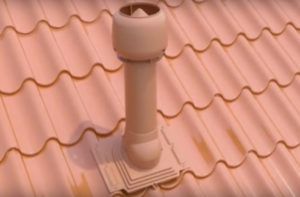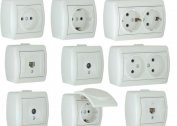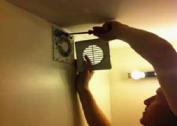If you already build a cottage or a bathhouse, then it is large-scale: with heating and ventilation. You just need to be prepared that these two systems carry a lot of difficulties. In this article we will look at how to equip the air care unit through the roof.
First of all, you need to figure out why such designs are used:
- general ventilation of rooms;
- roof ventilation elements, roof ventilation outlets;
- sewer ventilation;
- exit kitchen and toilet hoods;
- output of a central vacuum cleaner and other ventilation systems;
The structure of the duct passage
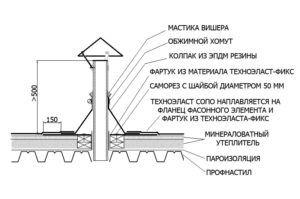 Designs from manufacturers are unique and have their own characteristics, but in general, the principle of operation of the duct care unit is similar. When creating a passage unit, galvanized steel can be used along with a heater. It often consists of a layer of mineral wool up to 5 centimeters.
Designs from manufacturers are unique and have their own characteristics, but in general, the principle of operation of the duct care unit is similar. When creating a passage unit, galvanized steel can be used along with a heater. It often consists of a layer of mineral wool up to 5 centimeters.
Particular attention should be paid to the fit points of the cap made of ethylene propylene (EPDM) rubber. It should be firmly pressed to the roof and to the chimney. That EPDM rubber is a protection against water for the site.
The assembly of the duct passage through the roof is fixed in the area of the apron. The fastening must be strong, as the duct must withstand not only gusts of wind, but also snow pressure. One way or another, in the northern latitudes, additional protection is established for protection from snow. Fixing the knot is important, and because backlash leads to extrusion of mastic or sealant, which protects against leakage.
They can also look completely different, which does not affect the functionality of the node. Whatever task he performs, the design must meet certain criteria.
Why this element requires increased attention:
- ventilation violates the integrity of the roof, so you need to take care of removing holes and gaps. Otherwise, the structure will begin to leak moisture, which will undoubtedly adversely affect its durability;
- temperature difference causes deformation of the components;
- if it is a chimney, it is necessary to equip the insulation for fire safety reasons.
Mounting the duct assembly
First of all, you need to choose a place on the roof, where it is most appropriate to place ventilation. Firstly, it is worth paying attention to the wind rose and choosing the location of the chimney so that the smoke goes away from the house. Secondly, it is equally important to determine the height of the pipe. The higher the pipe, the stronger the wind. In some cases, wind can interfere with natural draft, which is unacceptable in houses with stove heating. On the other hand, if the hole of the pipe is located below the ridge, part of the condensate or soot may settle on the roof.
By the way, all these details are described in the fire safety recommendations. Permissible elevations of chimneys above buildings below.
For horizontal roofs:
- above 1.5 m from the ridge of a nearby apartment building. When the chimney is 1.2 meters above the roof level, regardless of the angle of its inclination, installation of stretch marks is necessary;
- above the horizontal roof, the chimney must be positioned at least 0.5 m higher.
For pitched roofs:
- if the distance from the roof to the pipe is more than 3 meters, it should not be higher than the line that is drawn down from the ridge at an angle of 10 degrees relative to the horizon;
- at a distance from the ridge to the pipe from 1.5 to 3 meters, the height of the pipe should not be lower than the ridge;
- in other cases, the pipe should rise 0.5 meters above the ridge.
Phased installation
- A hole with a diameter under the duct is cut out in the roof. In this case, if it is a chimney of a boiler, fireplace or stove, it is necessary to provide for the installation of thermal insulation in order to avoid the risk of ignition of the roof insulation, lathing or waterproofing. To do this, just attach the rubber cap of the unit and draw a marker around the inner circle. Further, according to the figure, a hole is cut and / or sawn.
- Further, the lower part of the cap is treated with moisture-resistant adhesive-sealant and is attracted into place using roofing screws.
- In this case, another protective cap is put on top and is also attracted by roofing screws.
- The pipe itself is attached to it.
- Bottom hydro and vapor barrier are fixed with an additional lining.
Apron for protection against snow on a pitched roof
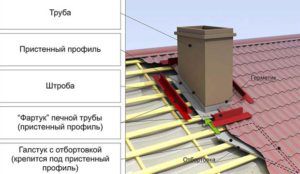 In the northern latitudes, even on pitched roofs, snow accumulates. Due to periodic heating of the area around the ventilation, the snow becomes hard or completely freezes. He poses a danger during the descent from the roof, especially for brick and square tin ventilation pipes, as they are less streamlined for snow mass.
In the northern latitudes, even on pitched roofs, snow accumulates. Due to periodic heating of the area around the ventilation, the snow becomes hard or completely freezes. He poses a danger during the descent from the roof, especially for brick and square tin ventilation pipes, as they are less streamlined for snow mass.
To protect the roof from snow and from leaking, it is customary to use power aprons. Tightly attached to the roof crate.
The upper side of the apron can be up to 20 cm high.
However, many builders find it possible to do without using such an apron. The solution to this problem is to install the unit directly on the ridge of the roof.
Duct through the ridge
The functional advantages of this method are not many. Firstly, the snow load is removed from the base of the site. Secondly, it becomes possible to conduct ventilation directly under the ridge, which is sometimes necessary on the attic floors. Ventilation under the ridge does not disturb the interior and frees up space. Another advantage is the design, because there are connoisseurs of just such an architecture.
The cons include the already mentioned wind, which can interfere with traction. The need for additional fixation of the pipe. However, the biggest difficulty is the need to invade the roof supporting structure. Those. to make the duct through the ridge, it must be torn and reconnected, freeing up central ventilation space. The rafter base is a very balanced system, and such interference can cause irreparable harm. Therefore, ventilation through the ridge should be attributed to complex structures and taken, having considered and considered everything.
Node marking
Currently, the construction market offers 11 types of ventilation passage units.
The letters "UP" are generally accepted markings. If there are no elements in the design of the units, the numbers from 1 to 10 indicate this. These include the condensate collection ring and the valve.
Numbers 2-10 indicate that the design is equipped with a controllable valve, and there is no condensate collection ring.
The symbols "UPZ-UPZ-21" indicate that the passage unit is fully equipped with: manual remote control, valve, condensate ring.
